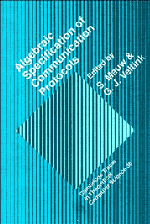Book contents
1 - Introduction
Published online by Cambridge University Press: 03 May 2010
Summary
AIM AND SCOPE
An important reason why formal description techniques are not appreciated as widely as wished by the developers of such techniques, is that people who actually design and implement software have relatively little knowledge of formal methods. The acceptance of formal techniques not only depends on the existence of techniques that are easy to understand and easy to use, but also on the training of potential users. This implies that there is a need for text books and case-studies. We think that a collection of formal specifications in a restricted area of application may help to get a better understanding of the use of formal techniques. Although the method we use is well suited for formal verification, we concentrate on the act of specification. A first requirement for a formal correctness proof is a formal specification.
We restrict ourselves in this book to a collection of specifications concerning one application area, the field of communication protocols. Although this seems to be an area with a relatively high acceptance of formal techniques, most of the protocols that are actually in use are specified in natural language, if ever specified otherwise than by the actual implementation. Even well-known and accepted standards, such as the token ring protocol, do not have a rigorous formal definition. Informal specifications in this area may lead to misinterpretations and, thus, to different implementations that will not be able to work together. Formal techniques are especially needed for communication protocol design, since these protocols describe distributed systems which have a high degree of non-determinism.
- Type
- Chapter
- Information
- Publisher: Cambridge University PressPrint publication year: 1993



